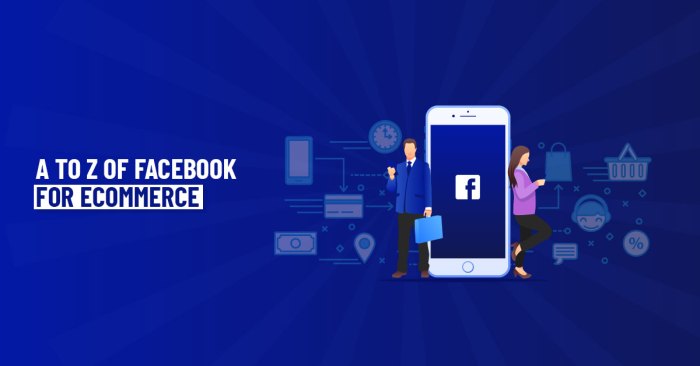Using Facebook for E-commerce kicks off a game-changing strategy for online businesses, tapping into the power of social media to boost sales and engage customers in a whole new way. From setting up a Facebook shop to mastering marketing strategies, this guide is your ticket to e-commerce success.
From product listings to customer engagement, we’ve got you covered with all the essential tips and tricks to make your online store shine on Facebook. Get ready to revolutionize your e-commerce game with the ultimate social media platform.
Introduction to Using Facebook for E-commerce

Facebook isn’t just for sharing memes and cat videos anymore, folks! It’s also a powerful tool for businesses looking to dip their toes into the world of e-commerce. By setting up shop on Facebook, businesses can reach a wider audience, increase sales, and build brand awareness like never before.
Leveraging Facebook for Selling Products Online
Businesses can leverage Facebook for e-commerce in a variety of ways:
- Setting up a Facebook Shop: Businesses can create a dedicated section on their Facebook page where customers can browse and purchase products directly.
- Targeted Advertising: With Facebook’s robust targeting options, businesses can reach specific demographics and interests to promote their products effectively.
- Engaging Content: By posting engaging content such as product photos, videos, and customer testimonials, businesses can create a buzz around their products and drive sales.
Benefits of Utilizing Facebook as an E-commerce Platform
There are several benefits to using Facebook as an e-commerce platform:
- Wider Reach: With over 2.8 billion monthly active users, Facebook provides businesses with a massive audience to tap into.
- Cost-Effective: Compared to traditional advertising methods, setting up an e-commerce presence on Facebook can be more cost-effective, especially for small businesses.
- Insights and Analytics: Facebook provides businesses with valuable insights and analytics to track the performance of their e-commerce efforts and make data-driven decisions.
Setting Up a Facebook Shop
To start selling products on Facebook, you need to set up a Facebook Shop. This feature allows businesses to showcase their products directly on their Facebook page, making it easier for customers to browse and purchase items without leaving the platform.
Steps to Set Up a Facebook Shop
- Create a Facebook Business Page if you don’t already have one.
- Go to the “Shop” tab on your page and click “Add Shop Section”.
- Agree to the Seller’s Terms and Policies and click “Continue”.
- Set up your payment method and fill in your business details.
- Add products to your shop by uploading photos, descriptions, and pricing.
- Once you’ve added products, click “Finish” and your Facebook Shop will be live.
Features of Facebook’s E-commerce Setup
Facebook Shops allow businesses to customize their online store, showcase products, and provide a seamless shopping experience for customers.
Yo, so you wanna learn about building a marketing research process? Check out this dope article on Building a Marketing Research Process. It’s crucial to have a solid plan in place to gather data, analyze trends, and understand your target audience. Don’t sleep on the importance of market research, homie!
- Integration with Instagram Shopping for cross-platform selling.
- Option to tag products in posts and stories for direct purchasing.
- Customer messaging for inquiries and support.
- Insights and analytics to track performance and optimize sales strategies.
Comparison with Other E-commerce Platforms
Setting up a Facebook Shop is relatively easy and free, making it accessible to businesses of all sizes. However, it may lack some advanced features compared to dedicated e-commerce platforms like Shopify or WooCommerce.
- Facebook Shop is integrated with the social media platform, offering a seamless shopping experience within the familiar environment of Facebook.
- Dedicated e-commerce platforms provide more customization options and advanced features for online stores.
- Facebook Shops are ideal for businesses looking to expand their online presence quickly and reach a large audience through social media marketing.
Product Listings and Management
Creating and managing product listings on Facebook for e-commerce is crucial for attracting customers and driving sales. Optimizing product descriptions and images can significantly improve visibility and engagement, while proper categorization and tagging ensure effective management of your inventory.
Yo, building a marketing research process is crucial for any business to thrive in today’s competitive market. You gotta check out this dope article on Building a Marketing Research Process to learn the ins and outs of gathering data, analyzing trends, and making strategic decisions. It’s all about staying ahead of the game and reaching your target audience, ya know?
Optimizing Product Descriptions and Images
- Use clear and concise product descriptions that highlight key features and benefits.
- Incorporate relevant s to improve searchability and reach a wider audience.
- Ensure high-quality images that accurately represent the product and catch the eye of potential buyers.
- Include multiple images from different angles to provide a comprehensive view of the product.
Importance of Product Categorization and Tagging
- Organize products into specific categories to make it easier for customers to navigate your shop.
- Assign relevant tags to products to enhance search functionality and help users find what they’re looking for quickly.
- Implement a consistent tagging system to maintain order and streamline inventory management.
Marketing and Advertising Strategies on Facebook: Using Facebook For E-commerce

In the world of e-commerce, having effective marketing and advertising strategies on Facebook can make a huge difference in reaching your target audience and driving sales. Let’s dive into some key strategies businesses can utilize to maximize their presence on this social media platform.
Targeted Ads for Audience Reach
- Create targeted ads based on demographics, interests, and behaviors to reach the right audience for your e-commerce products.
- Utilize Facebook’s ad targeting options to narrow down your audience and increase the chances of converting leads into customers.
- Monitor and analyze the performance of your ads to optimize for better results and ROI.
Role of Sponsored Posts and Collaborations, Using Facebook for E-commerce
- Consider sponsoring posts to increase the visibility of your e-commerce products and reach a wider audience beyond your followers.
- Collaborate with influencers or other businesses to promote your products through sponsored content, leveraging their existing audience for increased exposure.
- Engage with your audience through sponsored posts and collaborations to build trust and credibility for your e-commerce brand.
Customer Engagement and Support
Engaging with customers and providing support are crucial aspects of running a successful e-commerce business on Facebook. By actively interacting with customers through comments, messages, and live chats, businesses can enhance their brand image and establish trust with their audience.
Engaging with Customers
- Respond promptly to comments and messages: Show customers that you value their feedback and inquiries by providing quick and helpful responses.
- Encourage dialogue: Ask questions, run polls, and create engaging posts to spark conversations with your audience.
- Utilize live chat features: Offer real-time assistance to customers who need immediate support or have pressing questions.
Providing Excellent Customer Support
- Be proactive: Anticipate common customer queries and provide clear, concise answers in your product descriptions or FAQ section.
- Personalize interactions: Address customers by name and tailor your responses to their specific needs or concerns.
- Offer multiple support channels: In addition to Facebook, provide contact information for email or phone support for customers who prefer alternative communication methods.
Building a Community
- Create a Facebook group: Establish a space where customers can connect with each other, share experiences, and provide feedback on your products or services.
- Host events or contests: Organize virtual events or contests to engage with your community and reward loyal customers for their support.
- Show appreciation: Acknowledge and celebrate milestones, such as reaching a certain number of followers or successful product launches, to foster a sense of belonging among your audience.
